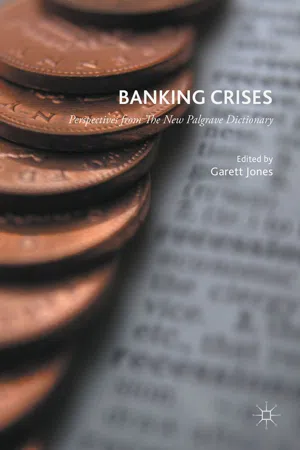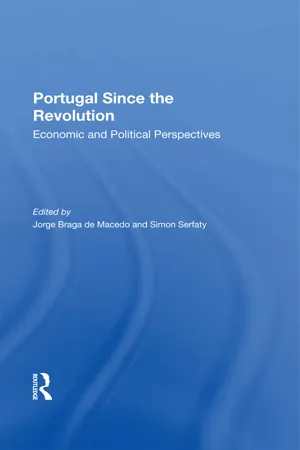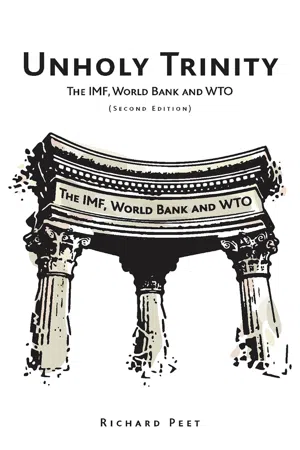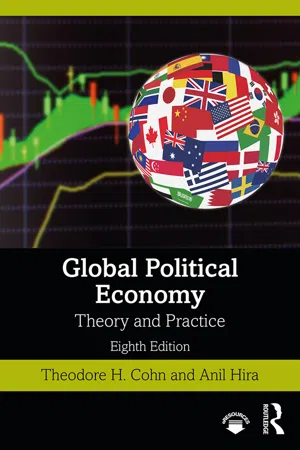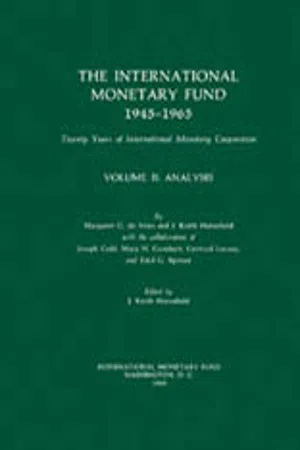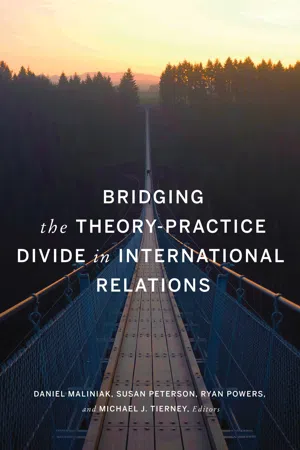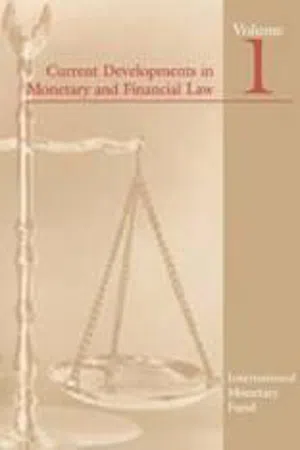International Monetary Fund
The International Monetary Fund (IMF) is an international organization that aims to promote global monetary cooperation, secure financial stability, facilitate international trade, promote high employment and sustainable economic growth, and reduce poverty around the world. It provides financial assistance to member countries facing balance of payments problems and offers policy advice and technical assistance to support economic stability and growth.
7 Key excerpts on "International Monetary Fund"
- eBook - ePub
Banking Crises
Perspectives from the New Palgrave Dictionary of Economics
- Garett Jones, Garett Jones(Authors)
- 2016(Publication Date)
- Palgrave Macmillan(Publisher)
...International Monetary Fund The International Monetary Fund (henceforth ‘the IMF’ or ‘the Fund’) was conceived at a conference at the Mount Washington Hotel in Bretton Woods, New Hampshire, in July 1944 and its Articles of Agreement entered into force in December 1945. The World Bank (henceforth ‘the Bank’) was set up at the same time. The IMF was established to promote international monetary cooperation and the elimination of exchange restrictions on current account transactions; to facilitate trade, economic growth and high levels of employment; to foster exchange rate stability; and to provide temporary financial assistance to countries so as to ease balance of payments adjustment. More specifically, it was given the role of supervising a system of pegged but adjustable exchange rates, which became known as the Bretton Woods system. In the first two sections of this entry we explain how the Bretton Woods system worked, and why it broke down in 1971. In the following sections we consider the roles which the Fund now plays, which differ from its original activities. They are: surveillance, ensuring stability for the international financial system and for individual economies within this system, and assisting the world’s poorest economies. As part of each of these three activities, the Fund also provides policy advice and technical assistance. This is a much less clear collection of responsibilities, and, as a result, the future direction of the Fund is somewhat uncertain. The aim of this article is to review the achievements of the Fund, and also the challenges that lie ahead...
- eBook - ePub
Portugal Since The Revolution
Economic And Political Perspectives
- Jorge Braga De Macedo, Simon Serfaty(Authors)
- 2019(Publication Date)
- Routledge(Publisher)
...After a few introductory comments on the Fund itself, this analysis will proceed on the basis of several distinct historical stages: (1) the pre-revolutionary period; (2) the move toward socialism; and (3) the return toward capitalism, subdivided according to the three rounds of negotiations with the IMF (1976–77, 1977–78, and 1978–79). Finally, the concluding sections will discuss alternative methods of stabilization, especially the role of stabilization in long-term development strategies. In this context, the British/Italian debate on deflation, devaluation, and import controls will be introduced and related to the Portuguese case. 1. The Role of the Imf The main goal of the International Monetary Fund, as outlined in the 1945 Articles of Agreement, was to promote an open international economy. Restrictions on free trade and restrictions on the movement of capital were to be firmly opposed. Subsidiary goals--necessary for the functioning of the open economy--were promotion of monetary cooperation, a multilateral payments system, exchange stability, and smooth adjustments of balance of payments equilibrium. 1 It was only a few years later that some economists realized that inflation could interfere with the achievement of these original goals. The 1948 Annual Report dealt specifically with this issue, and measures to control inflation began to be incorporated into the programs set out by the Fund. 2 In historical terms, it is clear that governments go to the Fund for one main reason--balance of payments crises. The IMF itself has small amounts of money to lend out, but much more important has been its role of lynchpin for the international lending system. That is, the IMF “seal of approval” has been required by other lenders before they will provide a government with credit. In the 1950s and 1960s, such loans came mainly from public sources--the World Bank and bilateral agencies, especially the United States Agency for International Development and its predecessors...
- eBook - ePub
Unholy Trinity
The IMF, World Bank and WTO
- Richard Peet(Author)
- 2009(Publication Date)
- Zed Books(Publisher)
...The institution, called the IMF, a specialized agency of the UN, was part of an envisaged system that also included a bank dealing with long-term investments (IBRD), a trade organization (ITO), and actions to promote full employment under the UN Economic and Social Council. The IMF would have a board of governors, representing all member countries, which met annually, an executive board, of which five members would be from countries with the largest quotas, meeting continuously, and a managing director, who was not a board member. Voting on both boards was to be according to quotas. Under the original quota system, the USA had 27.9 percent of the vote and the UK 13.3 percent (ibid.: ch. 5). There was one issue, later to become highly controversial, which divided the Americans and the Europeans. The European view of the lending operations of the IMF was that resources would be provided to member countries more or less on request, as they were needed. In particular the British delegates to Bretton Woods thought that members should be free to pursue whatever domestic policies they desired, even if these affected exchange rates, a central concern of the conference. By contrast, the Americans thought that borrowing foreign currency (dollars, as it turned out) from the IMF was not an unqualified right. At the Atlantic City pre-conference the US delegation proposed that the language of the proposed Articles of Agreement (Article V) be changed from a ‘member shall be entitled to buy another member’s currency from the Fund’ to a ‘member may buy the currency of another member from the Fund’ (emphasis added). The United Kingdom had the support of virtually all other countries in successfully opposing this change. While this indicates, however, that the USA did not entirely have its own way at Bretton Woods, subsequent practice at the IMF indicates otherwise...
- eBook - ePub
Global Political Economy
Theory and Practice
- Theodore H. Cohn, Anil Hira(Authors)
- 2020(Publication Date)
- Routledge(Publisher)
...Although the IMF still provided short-term balance-of-payments loans and the Bank provided long-term development loans, they both were now providing medium-term SALs to indebted countries. The greater overlap of IMF and Bank functions has increased both conflict and collaboration. The overlap also raises questions as to whether two institutions are necessary, and the Economist predicted in 1991 that a merger between the two “makes sense, and in time it will happen.” 61 However, the IMF and the Bank both perform important functions. First, the Bank group is composed of five institutions, and it is already too large for efficient management (see Chapter 11). Second, development issues are highly complex, and a range of institutions are needed to provide advice and loans. Although Marxists argue that IMF and Bank policies are virtually identical, liberal economists point to IMF–Bank disputes as an indication of competing perspectives. Third, IMF and Bank responsibilities extend well beyond providing loans. The IMF advises states on monetary and financial issues, and this role has become more important since the 2008 global financial crisis. As discussed in Chapter 11, the Bank by contrast is a source of economic expertise on development issues. 62 Although IMF–World Bank collaboration is partly designed to avert institutional conflict, the South is highly suspicious of these moves. Marxists and debtor states often see IMF conditionality as infringing LDC sovereignty, and they argue that the liberal economic conditions on IMF and World Bank loans hinder LDC development. IMF–Bank collaboration could result in cross-conditionality, in which an IMF decision that a loan applicant is uncreditworthy also prevents the applicant from receiving Bank funding...
- eBook - ePub
- International Monetary Fund(Author)
- 1996(Publication Date)
- INTERNATIONAL MONETARY FUND(Publisher)
...PART I The Formation and Objectives of Fund Policy CHAPTER 1 The Process of Policymaking Margaret G. de Vries O NE OF THE DISTINGUISHING CHARACTERISTICS of the international economic scene since World War II is the existence of multi-member economic institutions, such as the International Monetary Fund. The Fund was established to substitute cooperation and consultation in monetary and financial affairs for the unilateral and independent decision-making concerning these matters in which countries had previously engaged. Subsequently, in accordance with its Articles of Agreement, the Fund has been evolving policies in the fields for which it has responsibility that are of considerable significance to its members. IMPORTANCE OF THE FUND’S POLICIES The Fund’s attitudes and policies are an important factor circumscribing the monetary and financial policies of each member country. For several of its policies, a member is accountable to the Fund. Regular consultations between the Fund and the member provide the Fund with an opportunity to review and to criticize the monetary and financial policies being pursued by the member. Some actions contemplated by the monetary authorities of a member—such as a change in the exchange rate or the imposition of exchange restrictions—must receive the concurrence of the Fund even before these steps can be taken. A member has a vested interest in securing the Fund’s approval: not only may the member then be regarded as one in good standing in the international economic community, but it is enabled should the need arise to draw upon the pool of resources which the Fund has at its disposal. Through the medium of the Fund, a member has opportunities to comment upon the policies of other members and, should it feel that its interests are adversely affected by the policies of another, it has the right to object. Just as the Fund’s policies are of concern to a member individually, so are they important to its members collectively...
- Daniel Maliniak, Susan Peterson, Ryan Powers, Michael J. Tierney, Daniel Maliniak, Susan Peterson, Ryan Powers, Michael J. Tierney(Authors)
- 2020(Publication Date)
- Georgetown University Press(Publisher)
...This encompasses established international institutions, formal cooperation mechanisms, and informal arrangements and has changed substantially over the last seventy years. A short historical detour may be useful here. International Monetary and Financial Policy Cooperation since World War II Although the architecture for international cooperation in the area of monetary and financial policies has evolved continuously in line with changes in the world economy and the global political power balance, one could distinguish four different periods. The Bretton Woods Period (1945–1973) Following World War II, the Western powers’ priorities included financing reconstruction, restarting growth, and avoiding the trade wars of the 1930s. To achieve this, they put in place a new international monetary system, the Bretton Woods system, based on fixed exchange rates and anchored on the US dollar, whose value was in turn fixed to gold. To safeguard this system, they created an institutional framework—an architecture—with three pillars: the World Bank to finance reconstruction and development; the International Monetary Fund (IMF) to police the international monetary system and its members’ fiscal, monetary, and exchange rate policies; and the International Trade Organization, to promote orderly trade. Of these pillars, the first two were established immediately. Because of a lack of US support for the third, the informal General Agreement on Trade and Tariffs (GATT) was created instead, which was eventually transformed into a fully fledged entity, the World Trade Organization (WTO), in 1995. The three pillars of this architecture are treaty-based international organizations, with independent staff, and explicit internal governance and decision-making arrangements. Membership is open to all countries...
- International Monetary Fund(Author)
- 1999(Publication Date)
- INTERNATIONAL MONETARY FUND(Publisher)
...Criticisms that the IMF has been too rigid on fiscal policy seem therefore rather wide of the mark. More controversial has been the IMF’s insistence on the maintenance of high interest rates in the three programs. While it is undoubtedly true that high interest rates are a burden on enterprises, interest rates are also an important support for the exchange rate. The exchange rates of all three countries had suffered undue depreciations of varying magnitudes, sharply raising the domestic currency cost of servicing the private sector’s dollar debts. Exchange rate weakness therefore risked generating a far greater debt burden for the private sector than the high domestic interest rates used to resist this weakness: hence the priority accorded to the prevention of further depreciations through the maintenance of a tight monetary policy. As noted, all three of the Asian cases also involved action in the financial sector, with measures to close insolvent banks, restore confidence in the remaining banks, and improve the regulatory and supervisory arrangements. These measures, which can be considered the core of the structural reform program now under way in Asia, are described in more detail in the paper by Mr. Charles Enoch of the Monetary and Exchange Affairs department of the IMF. 4 3D. Recent Financial Crises: Institutional Responses CHARLES A. ENOCH Financial crises have occurred in many countries in recent years, in all regions. A commonly quoted statistic is that more than half the membership of the IMF has experienced banking sector problems in one form or another in the last ten years. The extent of these crises has varied. In some cases, there was just a series of simultaneous banking failures—serious enough, but manageable through taking actions with regard to only the banking sector. In other cases, the financial crises were more pervasive—involving also a combination of one or more of debt crisis, fiscal crisis, and currency crisis...
